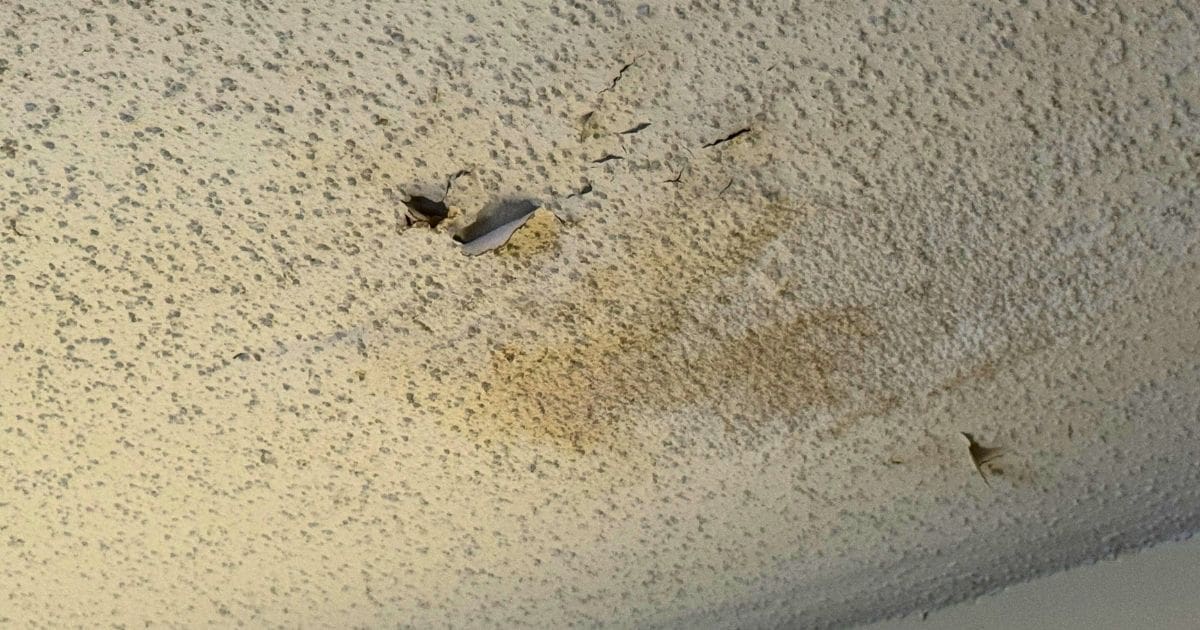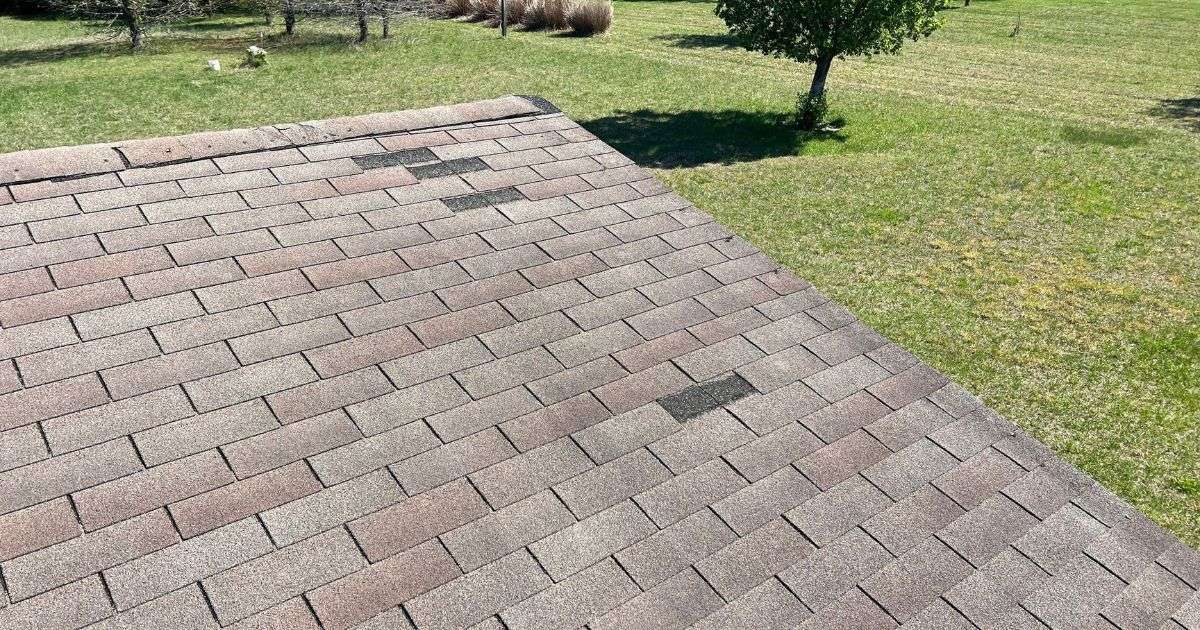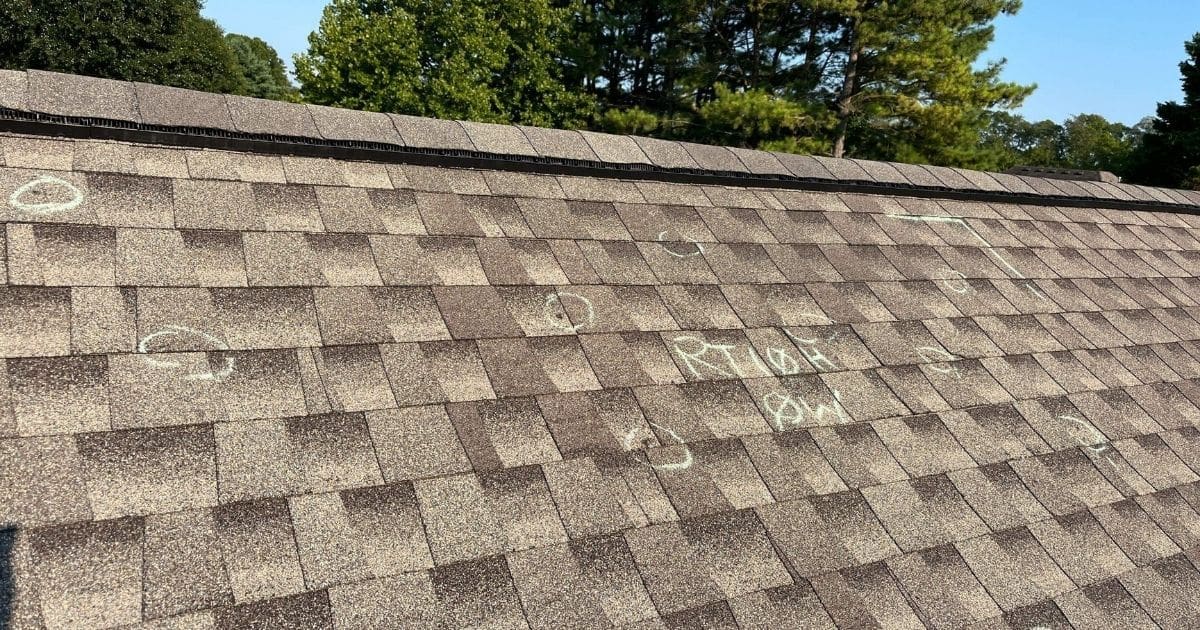Drip to Disaster: A Homeowner's Guide to Roof Leak Repair

Your roof protects your home. Even small leaks can cause big problems if ignored, leading to expensive structural, mold, and insulation issues. This guide covers everything from finding leaks to getting them professionally fixed.
Part 1: The Telltale Signs of a Roof Leak
It’s easy to miss the early signs of a roof leak until a lot of damage has happened. By spotting and fixing these signs early, homeowners can avoid expensive repairs. Catching problems quickly is key to preventing major damage. Your roof might be in trouble if you notice these common warning signs:
Water Stains on Ceilings and Walls
Yellow-brown stains on your ceilings or walls mean you likely have a roof leak. Water seeping through your roof creates these stains on the wood, insulation, and drywall, picking up dirt as it goes. Dry stains mean water got in before, which still points to an ongoing or on-and-off leak that needs immediate attention. Ignoring them can lead to structural damage, mold, and poor indoor air quality.
Dripping Sounds
Hearing a constant drip during or after rain is a big clue. Even if you don’t see water, dripping sounds mean water is collecting in your attic, walls, or ceiling. Hidden water buildup can soak insulation, rot wood, and cause mold growth, seriously harming your home’s structure and your family’s health. No visible water doesn’t mean no problem; it means trapped water is causing unseen damage.
Missing or Damaged Shingles

Check your roof from the ground (use binoculars for a closer look) to spot any outside damage. Shingles are your roof’s main shield. Any damage to them creates a direct path for water to get into your home. Look for:
- Cracked Shingles: Cracks, especially those that go all the way through the shingle, can let water in.
- Curled Shingles: Shingles that curl at the edges or corners often show age, sun damage, or improper installation, making them less able to shed water.
- Buckled Shingles: Wavy shingles point to moisture problems or poor ventilation.
- Missing shingles: These expose the layers underneath and the roof deck to water, inviting leaks.
Exterior Inspection Checklist
Besides just the shingles, it’s important to do a full outside check of your roof and nearby parts. When you’re looking, pay close attention to:
- Damaged Flashing: These are thin metal strips (aluminum or galvanized steel) around roof openings like chimneys, vents, skylights, and roof valleys. Their job is to create a watertight seal. Flashing that’s cracked, bent, rusted, improperly installed, or pulling away is a common cause of roof leaks. Water can easily get in through damaged flashing points.
- Clogged Gutters: Gutters and downspouts are designed to guide rainwater away from your home’s foundation. When gutters get blocked with leaves, twigs, shingle grit, and other stuff, water can’t flow freely. Overflowing gutters cause water to pool, possibly seeping under shingles or into eaves, damaging the attic or outside walls.
- Granules in Your Gutters: Asphalt shingles have a coating of mineral granules that protect them from UV rays and give them color. As shingles get old and wear out, these granules shed. Lots of granules in your gutters or downspouts mean your shingles are aging, increasing the risk of leaks.
Attic Inspection

Safely check your attic for signs of a leaky roof. With a bright flashlight, systematically scan the underside of your roof deck, rafters, and insulation. Look for:
- Wet or Damp Insulation: Insulation that feels wet, damp, or looks squished down is a clear sign of water getting in. Wet insulation loses its ability to insulate, making your home less energy-efficient and encouraging mold.
- Brownish or Dark Water Stains: on the exposed plywood or OSB sheathing of the roof deck point to where water is entering. These stains can also mean rotting wood if the leak has been going on for a while.
- Visible mold (black, green, or white fuzzy patches) or a musty, earthy smell in the attic means constant moisture. Mold can cause health problems and shows a sustained leak that needs to be fixed right away.
Regular checks and quick action on roof problems prevent expensive damage, protecting your home and your investment.
Part 2: Common Culprits: What Causes Roof Leaks?
Knowing what causes a leak is key, not just for fixing it but also for stopping it from happening again. While a pro will find the exact problem, homeowners can learn about the most common issues. These are the spots where roofs are weakest and where leaks usually start:
- Old or Broken Shingles: Sun, wind, rain, and hail wear down shingles over time. This causes cracks, curling, buckling, or losing their grit, which leads to leaks. Checking them often stops things from getting worse.
- Clogged Gutters: Stuff in gutters stops water from draining right, causing it to back up and sit there. This leads to rot, decay, and leaks. Cleaning them regularly is an easy way to prevent this.
- Broken or poorly put-in flashing at roof seams: Problems with flashing are common leak spots where the roof is interrupted, letting water sneak in.
- Ice Dams: In cold places, ice dams form at the roof edges when melted snow refreezes. This forces melted snow under shingles and causes leaks into attics and walls. Good attic insulation and ventilation stop ice dams.
- Badly sealed roof openings (vents, pipes): Plumbing vents, exhaust fans, stove pipes, and satellite dish mounts are common leak points. The roof sealant wears out due to age, temperature, and sun, letting water in and causing ceiling stains.
Part 3: What to Do When You Find a Leak: A Step-by-Step Guide
A roof leak is stressful, but acting fast can prevent big problems. Here’s what to do as soon as you think you have a leak:
Stop Interior Damage Right Away:
- Catch the Water: Your first goal is to stop water from spreading and causing more damage. Put a strong bucket, large bowl, or even a trash can right under the drip. If the leak is wide, you might need several containers.
- Discolored, soft ceiling bulges mean water is building up. Carefully poke a hole in this bulge with a screwdriver or a small nail. This helps release the pressure, stopping a bigger ceiling collapse. Be ready for water to gush out.
- Protect Your Stuff: Quickly move any furniture, electronics, rugs, artwork, and other valuable items out of the wet area. Water can ruin wood, electronics, and fabrics. If you can’t move items, cover them with plastic sheets or tarps.
Don't Try Big DIY Repairs – Focus on Safety and Pros:
- Fight the Urge: It’s normal to want to fix the problem yourself, especially if you’re good with your hands. But we strongly advise against trying major DIY roof repairs.
- Safety First: Climbing onto a roof, especially one that’s damaged or wet, is very dangerous. There’s a high risk of falling and getting seriously hurt.
- Not knowing what you’re doing or having the wrong tools can make roof damage worse, leading to more expensive fixes. You might guess the problem wrong, use the wrong materials, or hurt the roof’s structure. Let trained and equipped pros handle complex repairs.
Document the Damage for Insurance:

- Take photos/videos of all affected areas when it’s safe. Document not only where the leak is coming from (if you can see it) but also all the damage inside.
- Photograph all water damage, including stains on ceilings and walls, soaked floors, and damaged furniture.
- Ideally, use a camera that stamps photos with the date and time, or just write down the date and time. This documentation is key for your insurance claim, giving solid proof of the damage. The more details you provide, the smoother the claims process will be.
Call a Professional Roofer Right Away:
- Expert Check: Contact a qualified roofing contractor. They have the knowledge, tools, and safety gear to check the damage, find the leak’s source, and do lasting repairs.
- Emergency Services: Many professional roofers offer emergency services for leaks, knowing how urgent the situation is. Don’t hesitate to ask about their availability for urgent calls.
- Choosing a Contractor: Pick licensed, insured roofers with good reviews and references. Get several quotes if you have time, and make sure they give you a detailed plan of work before starting any repairs.
Part 4: The Professional Repair Process – What to Expect When You Call a Roofer
For lasting roof leak repair, hire a professional roofer. Engaging a reputable company ensures that the repair is done correctly, preventing future issues and safeguarding your home. Here’s a detailed breakdown of what you can typically expect when you enlist their expertise:
A Thorough and Systematic Inspection:
This is arguably the most critical step in the professional repair process. A skilled roofer won’t just look for obvious water stains inside your home. They will conduct a comprehensive and systematic inspection, both inside and out.
- Interior Inspection: Look for water stains, mold, or damaged insulation in the attic; they’ll trace the water’s path to its entry point.
- Exterior Inspection: A thorough roof examination for missing/damaged shingles, cracked flashing, deteriorated sealants, clogged gutters, and other water entry points. They’ll also inspect eaves, fascia, and soffits for rot or water damage, finding subtle issues an untrained eye might miss.
Transparent Estimate:
After identifying the leak’s source and extent, a professional roofer will provide a written estimate. This document is crucial for transparency and should clearly outline:
- Scope of Work: Precise description of roof repairs needed, including specific areas to be addressed.
- Materials: Type and quality of roofing materials (shingles, flashing, underlayment, sealants, etc.) for repair.
- Cost Breakdown: A clear itemization of labor costs, material costs, and any other associated fees. There should be no hidden charges.
- Timeline: An estimated timeframe for the completion of the repairs.
- Payment Terms: Information regarding deposits, progress payments, and final payment.
- Permitting (if necessary): If the repair is extensive and requires local permits, the estimate should mention this.
Reputable roofers use high-quality, durable materials suitable for your roof and climate. Beyond materials, their workmanship is paramount. Professional roofers ensure lasting repairs, adhering to industry standards. They have the tools, training, and experience to safely and efficiently execute the repair, ensuring proper installation and sealing to prevent future leaks.
Professionals offer valuable warranties. Reputable roofing companies warranty materials and labor. Warranty ensures prompt, free repair of related issues within the period. This commitment reflects their confidence in their skills and the quality of their work.
Your Roof's Health is Your Home's Health – A Crucial Connection
Your roof isn’t just a cover; it’s your home’s main protector. Your roof’s condition impacts your home’s health and lifespan. Neglecting even a seemingly minor drip can quickly escalate into a catastrophic problem, leading to:
- Extensive Structural Damage: Water weakens wooden beams, joists, and framing, compromising structural integrity.
- Leaks cause dampness, leading to mold/mildew growth, odors, and health risks, especially for allergy/respiratory sufferers.
- Wet insulation increases energy bills as HVAC systems overwork.
- Common Roof leaks cause costly interior damage: water stains, peeling paint, warped drywall, and damaged flooring, harming home aesthetics.
- Electrical Hazards: Water and electricity are dangerous. Leaks near wiring or fixtures create fire/shock hazards.
Early leak detection—water stains, musty odors—and prompt action prevent costly damage. Don’t delay; contact a trusted local roofing professional immediately. Timely professional repair ensures your roof’s health, home’s safety, and peace of mind.

